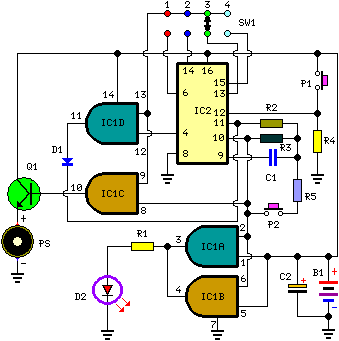- Long Delay Timer Circuit Diagram
- Jogging Timer Circuit Diagram
- Amplifier Timer Circuit Schematic
- A Very Useful Timed Beeper Circuit Schematic
- A Bedside Lamp Timer Circuit Schematic
- Safety Guard
- Midnight Security Light Circuit Schematic
- Power-Off Time Delay Relay
- Power-On Time Delay Relay
- Generating a Delayed Pulse Using The 555 Timer
- 555 timer Mono stable (one shot) circuit
- Generating Long Time Delays
- Low Voltage, High Current Time Delay Circuit
- 9 Second Digital Readout Countdown Timer
- 9 Second LED Timer and Relay Circuit
A Very Useful Timed Beeper Circuit Schematic
Description
This circuit is intended for alerting purposes after a certain time is elapsed. It is suitable for table games requiring a fixed time to answer a question, or to move a piece etc. In this view it is a modern substitute for the old sandglass. Useful also for time control when children are brushing teeth (at least two minutes!), or in the kitchen, and so on.
Circuit diagram:
Parts:
- R1 = 220R
- R2 = 10M
- R3 = 1M
- R4 = 10K
- R5 = 47K
- C1 = 100nF-63V
- C2 = 22µF-25V
- D1 = 1N4148
- D2 = 3mm. Red LED
- Q1 = BC337
- P1 = SPST Pushbutton (Start)
- P2 = SPST Pushbutton (Reset)
- PS = Piezo sounder (incorporating 3KHz oscillator)
- B1 = 3V Battery (2 AA 1.5V Cells in series)
- IC1 = CD4081 Quad 2 input AND Gate IC
- IC2 = CD4060 14 stage ripple counter and oscillator IC
- SW1 = 4 ways Switch (See notes)
Circuit operation:
Pushing on P1 resets IC2 that start oscillating at a frequency fixed by R3 & C1. With values shown, this frequency is around 4Hz. LED D2, driven by IC1A & B, flashing at the same oscillator frequency, will signal proper circuit operation. SW1 selects the appropriate pin of IC2 to adjust timing duration:
- Position 1 = 15 seconds
- Position 2 = 30 seconds
- Position 3 = 1 minute
- Position 4 = 2 minutes
When the selected pin of IC2 goes high, IC1C drives Q1 and the piezo sounder beeps intermittently at the same frequency of the LED. After around 7.5 seconds pin 4 of IC2 goes high and IC1D stops the oscillator through D1. If you want to stop counting in advance, push on P2.
Notes:
- SW1 can be any type of switch with the desired number of ways. If you want a single fixed timing duration, omit the switch and connect pins 9 & 13 of IC1 to the suitable pin of IC2.
- The circuit's reset is not immediate. Pushing P2 forces IC2 to oscillate very fast, but it takes some seconds to terminate the counting, especially if a high timer delay was chosen and the pushbutton is operated when the circuit was just starting. In order to speed the reset, try lowering the value of R5, but pay attention: too low a value can stop oscillation.
- Frequency operation varies with different brand names for IC2. E.g. Motorola's ICs run faster, therefore changing of C1 and/or R3 values may be necessary.
- You can also use pins 1, 2, 3 of IC2 to obtain timings of 8, 16 and 32 minutes respectively.
- An on-off switch is not provided because when off-state the circuit draws no significant current.
